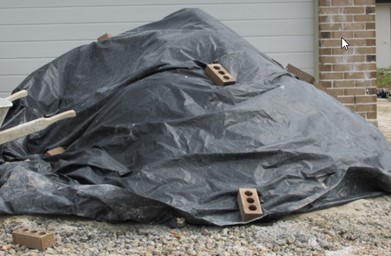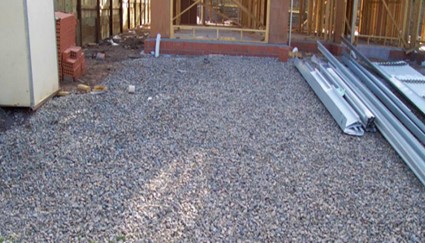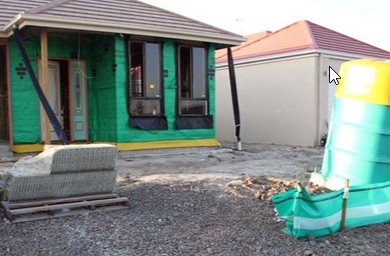Living Here
- Pets and Animals
- Residents
- Report
- Environment
- BackEnvironment
- Air Quality
- Biodiversity
- Biosecurity
- Blue-green algae blooms
- Bushfire Mitigation
- Coasts and Coastal Vegetation
- CoastSnap
- Conservation Programs and Initiatives
- Erosion and Sediment Control
- Feral Animals
- First Nations Fire and Land Officer
- Landfill Gas Abatement
- Mosquitoes
- Pests and Weeds
- Weed Spray Equipment Hire
- Wildlife
- Community Development
- Community Investment
- Services
- Emergencies
Erosion and Sediment Control (ESC)
ESC compliance program
Benefits of implementing best practice ESC
Information and resources
Council is committed to continuous improvement placing the environment in front of mind in what we do. This commitment is embedded in strategies outlined in our 2021-2026 Corporate Plan.
To meet our goals and objectives, Council has established an Erosion and Sediment Control (ESC) compliance program to promote best practice in ESC.
This program provides information on:
- Your obligations
- The importance of compliant ESC measures
- Ways to reduce soil and sediment runoff.
Through education and awareness, the program aims to:
- Reduce environmental harm
- Protect natural areas and waterways
- Increase ESC compliance
- Reduce contamination from building sites
- Reduce environmental nuisance issues.
Rainfall can result in large amounts of pollutants such as sediment, concrete wash-out waste and general rubbish that discharge into local drains, creeks, waterways and the ocean.
Sediment has a significant impact on the health of our waterways as nutrients and other pollutants attached to sediments have the potential to be released into the marine environment.
Overall, waterway pollution can reduce the aesthetic and recreational value of water bodies and has both short and long-term impacts on aquatic ecosystems, including the death of fish from clogging of their gills, smothering of aquatic plants and benthic organisms and degrading of water quality impacting growth rates and mortality rates.
Planning, installing and maintaining appropriate erosion and sediment controls along with appropriate waste management and disposal is essential for activities and can save costs and mitigate adverse environmental impacts.
ESC compliance program
Council conducts audits and inspections of building sites as part of our ESC compliance program.
It is your responsibility to prevent sediment and waste leaving your site.
Refer to the Queensland Government’s advice on Erosion and sediment control on construction sites.
In Queensland, everyone has two duties under the Environmental Protection Act 1994 that they must follow:
- A general environmental duty
- A duty to notify of environmental harm.
Preventing sediment and litter from entering our waterways is a legal requirement under the Environmental Protection Act 1994 as it is an offence to unlawfully deposit soil or other contaminants in waters, a roadside gutter or stormwater drainage.
It is an offence to undertake earthwork or another activity that exposes the earth in a way that the material could reasonably be expected to wash, blow, fall or otherwise move into waters, a roadside gutter or stormwater drainage, without taking all reasonable and practical measures available.
In accordance with Council’s Compliance and Enforcement Policy, Council officers will use a variety of tools to maintain the health of our waterways. This may include:
- Issuing a direction notice requiring you to act
- Issuing a penalty infringement notice (monetary fine)
- Prosecution.
By satisfying your general environmental duty, you can be compliant under the act and avoid receiving penalties.
Once you take possession of your new home, it is your responsibility to ensure soil and sediment do not leave your property.
- The best way to control erosion and sediment runoff is to have appropriate ground cover with grass, gravel, mulch or geofabric
- Inspect and maintain your erosion and sediment controls until the landscaping, ground cover/turf is established
- Faulty erosion and sediment controls should be replaced within 48 hours
- Remove any litter and waste material that may wash onto the footpath, driveway, gutter or roadway.
You are responsible for implementing and maintaining best practice erosion and sediment control measures on all your properties, including vacant land under your control.
Refer to the Queensland Government’s advice on meeting environmental obligations and duties.
To assist builders, information on measures to avoid sediment and waste leaving your site is available from Water by Design, including:
- Erosion and Sediment Control Toolkit for House Builders – House Toolkit
- ESC Factsheets 2022
- ESC Checklists 2022
Waterway protection measures
Waterway pollution from sediment release through development or construction activities is preventable. Most of this sediment is a result of exposed soil disturbed during construction activities including the clearing of vegetation.
Pollution of our waterways can be prevented by good planning and appropriate site management. Builders must install compliant erosion and sediment control measures before starting ground disturbing works. These control measures are to remain in place until handover.The following erosion and sediment control measures can be implemented for erosion and sediment control compliance for gently sloping sites that are less than 1000 metres.
Erosion control
- Ensure all building materials, skips, portaloo’s etc., are kept within the property boundary
- Ensure compliant ESC measures are in place prior to groundwork
- Clearing just prior to commencing works, and limiting clearing to only areas necessary to undertake building work
- Cover areas of bare soil as soon as possible e.g., use temporary covers such as spray on soil binders, mulch, gravel, sheeting plastic, geofabric
- Avoid disturbing grasses areas, e.g., restrict driving or parking on grassed areas and have a designated parking area
- Cover stockpiles when not in use
- Maintain grass and vegetation on undisturbed areas
- Install a suitably sized rock/gravel pad or rumble grid at entry /exit points to prevent sediment tracking onto the road (use clean, fines free gravel).

Stockpile covered and secure from wind. Source: Healthy Land and Water
More information on erosion control is available from Healthy Land and Water:

Example of an entry point rock / gravel pad Source: Brisbane City Council
Sediment control
The following measures will help prevent sediment leaving your site:
- Install a sediment barrier such as sediment fencing in an area where it can effectively contain and prevent water from moving down slopes
- Maintain a stabilised entry /exit rock pad and clear tracked material / soil from the road
- Divert dirty water behind sediment barriers
- Prevent runoff from entering stormwater gutters and pits
- Install coir logs, sandbags, or silt socks to protect stormwater inlets.
More information on erosion control is available from Healthy Land and Water:
Drainage control
10mm of rain on an average suburban roof of 200m2 can produce 2000 litres of rainwater. To reduce the volume of contaminated runoff by diverting clean stormwater from site:
- Install temporary or permanent downpipes as soon as the roof is in place. This will also help to keep the area dry and workable
- Divert upslope runoff to site catch drains and basins
- Maintain stormwater flow paths.
More information on erosion control is available from Healthy Land and Water:

Example of temporary downpipes on a new house. Source: Catchments & Creeks PTY LTD
Waste and other pollutants
To manage waste and protect the environment:
- Place all waste in a bin preferably with a secure lid and recycle where practical
- Clean up waste and spills immediately
- Contain and dispose of concrete waste, paint and any other trade waste appropriately
- Keep your site tidy and secure, even when unattended
- Be prepared for weather conditions. A well-managed site is a site that is appropriately prepared for both likely and unlikely (but possible) weather conditions.
More information is available:
You are responsible for appropriate governance controls and contracts on your project that outlines erosion and sediment control as well as waste management on site.
You are required to take all reasonable and practical steps to prevent material and sediment laden water from discharging off your site. This includes developing and implementing appropriate erosion and sediment control plans that meet your general environmental duty.
Council requires you to:
- Provide a concept erosion and sediment control plan (ESC plan) with your development application containing specification on the treatment train and preliminary calculations of sizing of sediment basins
- Allow for erosion and sediment control within development costs
- Provide Council with an ESC plan before commencing any works on site including clearing
- Undertake regular inspections (at least monthly and before and after rain) of erosion and sediment measures and maintain controls as required.
Construction erosion and sediment control (ESC) plans
The requirements of construction erosion and sediment (ESC) plans are outlined in the following documents:
The ESC plan must cover all stages of work on the site and include:
- Detailed calculations
- Drawings of drainage and sediment basins.
The ESC plan must be certified by:
- A professional engineer (RPEQ) with training in erosion and sediment control
- A Certified Practitioner in Erosion and Sediment Control (CPESC).
The Engineer or CPESC is to certify that the:
- Controls will achieve the State Planning Policy 2017 stormwater outcomes including that all exposed areas greater than 2500m2 have controls designed to achieve 50mg/L total suspended solids (TSS) or less, with 80% effectiveness
- ESC plan is in accordance with an accepted erosion and sediment control guideline, such as the IECA best practice guidelines for erosion and sediment control.
Check your site by using the checklist included in the Queensland Government Procedural Guide.
Refer to Water by Design's ESC factsheet and ESC checklist for more information:
Information for developers is available on Council’s website at www.gladstone.qld.gov.au/developers.
For more information or enquiries, contact Council on (07) 4970 0700.
It is your responsibility to manage the potential environmental impacts on your site, including preventing sediment and waste moving off site. You have a duty to develop a plan and implement controls that meet legislative requirements.
Key measures to comply with your general environment duty include:
- Implement the erosion and sediment control plan (ESC plan) which has been certified and inspected
- Meet the Environmental Protection Act 1994 and state planning policy requirements
- Conduct an effective monitoring program that measures and records the quality of all releases to stormwater and waterways
- Regularly review controls on site, maintain and modify controls as necessary.
For further information refer to IECA best practice guidelines for erosion and sediment control or contact a suitably trained professional.
Benefits of implementing best practice ESC
- Comply with the Environmental Protection Act 1994
- Less downtime and fewer clean-up costs
- All weather site access
- Improved business image and reputation
- Reduced soil /material loss
- Improved aesthetic and recreational values of our water bodies.
More information can be found on the Water by Design website.
For more information contact Council on (07) 4970 0700.
Information and resources
Information on the state of our rivers is available on the Healthy Land and Water Report Card.
Erosion and sediment control requirements:
- State Planning Policy 2017 (includes construction phase stormwater management design objectives)
- Gladstone Regional Council Planning Scheme
- Queensland Government Department of Environment, Science and Innovation provide checklists to assist you in complying with the Environmental Protection Act 1994 including:
- Procedural Guide - releases to waters from building sites and small construction sites (less than 2500m2)
- Procedural Guide - releases to waters from land development sites and construction sites 2500m2 and greater.
- International Erosion Control Association best practice erosion and sediment control document is the current reference standard for erosion and sediment control on sites greater than 2500m2
- Water by Design website resources include fact sheets and videos.
- Healthy Land and Water factsheets include:
- Erosion and sediment control factsheets and checklists
- Sediment management on construction sites
Reporting pollution
To report pollution incidents to the Queensland Government call the 24/7 Pollution Hotline on 1300 130 372.
Report sediment or litter entering a roadside gutter, stormwater system or waterway online or contact Council on (07) 4970 0700.
Living Here
- Pets and Animals
- Residents
- Report
- Environment
- BackEnvironment
- Air Quality
- Biodiversity
- Biosecurity
- Blue-green algae blooms
- Bushfire Mitigation
- Coasts and Coastal Vegetation
- CoastSnap
- Conservation Programs and Initiatives
- Erosion and Sediment Control
- Feral Animals
- First Nations Fire and Land Officer
- Landfill Gas Abatement
- Mosquitoes
- Pests and Weeds
- Weed Spray Equipment Hire
- Wildlife
- Community Development
- Community Investment
- Services
- Emergencies
Gladstone Regional Council
Connect. Innovate. Diversify.
Get in Touch
Phone
(07) 4970 0700
Opening Hours
8.30am - 5pm Monday to Friday
Social media
Postal Address
PO Box 29, Gladstone Qld 4680
Council Offices
101 Goondoon Street, Gladstone Qld 4680
3 Don Cameron Drive, Calliope Qld 4680
41 Blomfield Street, Miriam Vale Qld 4677
Cnr Wyndham & Hayes Avenues, Boyne Island Qld 4680
Rural Transaction Centres
71 Springs Road, Agnes Water Qld 4677
47 Raglan Street, Mount Larcom Qld 4695
Footer Acknowledgement
Gladstone Regional Council would like to acknowledge the Bailai, the Gurang, the Gooreng Gooreng and the Taribelang Bunda people who are the traditional custodians of this land. Gladstone Regional Council would also like to pay respect to Elders both past, present and emerging, and extend that respect to other Aboriginal and Torres Strait Islander people. Learn more about Council's Reconciliation Action Plan (RAP).
Chat Popup
All content © Gladstone Regional Council. All Rights Reserved.
Back to the top







